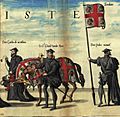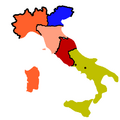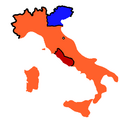Kingdom of Sardinia facts for kids
Quick facts for kids
Kingdom of Sardinia
|
|||||||||||||||||||||
|---|---|---|---|---|---|---|---|---|---|---|---|---|---|---|---|---|---|---|---|---|---|
| 1324–1861 | |||||||||||||||||||||
|
Civil Flag and Ensign of the Savoyard Kingdom (1816-1848)
Coat of arms (1815)
|
|||||||||||||||||||||

|
|||||||||||||||||||||
| Capital | Cagliari (1324–1720, 1798–1814) Turin (1720–1798, 1814–1861) |
||||||||||||||||||||
| Government | Absolute monarchy (1324–1849) Parliamentary constitutional monarchy (1849–1861) |
||||||||||||||||||||
| King | |||||||||||||||||||||
|
• 1324–1327
|
James II of Aragon (first) | ||||||||||||||||||||
|
• 1849–1861
|
Victor Emmanuel II of Savoy (last) | ||||||||||||||||||||
| Prime Minister | |||||||||||||||||||||
|
• 1848
|
Cesare Balbo (first) | ||||||||||||||||||||
|
• 1860–1861
|
Camillo Benso (last) | ||||||||||||||||||||
| Legislature | Parliament | ||||||||||||||||||||
| Subalpine Senate | |||||||||||||||||||||
| Chamber of Deputies | |||||||||||||||||||||
| History | |||||||||||||||||||||
| 1297 | |||||||||||||||||||||
| 1324 | |||||||||||||||||||||
| 1714 | |||||||||||||||||||||
| 1720 | |||||||||||||||||||||
|
• Perfect Fusion
|
1848 | ||||||||||||||||||||
|
• Loss of Savoy and Nice
|
1860 | ||||||||||||||||||||
|
• Becomes the new Kingdom of Italy
|
1861 | ||||||||||||||||||||
| Area | |||||||||||||||||||||
| 1859 | 73,810 km2 (28,500 sq mi) | ||||||||||||||||||||
|
|||||||||||||||||||||
| Today part of | Italy France Monaco |
||||||||||||||||||||
The Kingdom of Sardinia was a powerful state in Southern Europe that existed from the early 1300s to the mid-1800s. It started with the islands of Corsica and Sardinia. The leader of the Catholic Church claimed to rule these islands.
In 1324, James II of Aragon and the kings who came after him took control of the island of Sardinia. By 1420, they had bought out the last group that also claimed the island. After the kingdoms of Aragon and Castile joined, Sardinia became part of the huge Spanish Empire.
Contents
How the Kingdom Changed Hands
From Spain to Austria and Savoy
In 1720, the island of Sardinia was given to the Duke of Savoy, Victor Amadeus II. This happened after a big war where different families, the Habsburgs and the Bourbons, fought over who would rule Spain.
The Savoy family then joined Sardinia with their lands on the Italian mainland. These mainland areas included Piedmont, Savoy, and Nice. Over time, the Kingdom of Sardinia became more known for its mainland parts.
Napoleon's Influence and Return to Power
When Napoleon's France took over the Savoy family's mainland areas, the King of Sardinia had to move. For the first time, a Savoyard king lived on the island of Sardinia itself.
After Napoleon was defeated, European leaders met at the Congress of Vienna (1814–15). They decided to give the Savoy family their mainland lands back.
Becoming the Kingdom of Italy
Uniting the Different Regions
In 1847–48, a big change called the "Perfect Fusion" happened. All the different lands ruled by the Savoy family were brought together under one legal system. The capital city became Turin. They also got a new set of rules for the country called the Statuto Albertino.
By the time of the Crimean War in 1853, the Savoy family had made the kingdom very strong. On March 17, 1861, the Kingdom of Sardinia officially changed its name to the Kingdom of Italy. The capital later moved to Florence and then to Rome.
The Kingdom of Piedmont-Sardinia, led by the Savoy family, was the main state that led to the creation of the Kingdom of Italy. Today, the Italian Republic is the modern country that came from this history.
Important Rulers of Sardinia
- Philip V of Spain: He ruled over the huge Spanish Empire, which included Sardinia for a time.
- Victor Amadeus II of Sardinia: He was the first ruler from the House of Savoy to govern the territory.
- Victor Emmanuel II of Italy: He was the last king of Sardinia and later became the first king of a united Italy.
Images for kids
-
The flag of the Kingdom of Sardinia at the funeral ceremony of Charles V
-
King Victor Emmanuel II meets Garibaldi in Teano (26 October 1860)
-
The Kingdom of Sardinia from 1410 to 1420, after the defeat of the Arborean Judicate in the Battle of Sanluri (1409).
-
1859: Kingdom of Sardinia Kingdom Lombardy–Venetia Duchies Parma–Modena-Tuscany Papal States Kingdom of the Two Sicilies
-
1860: Kingdom of Sardinia Kingdom Lombardy–Venetia Papal States Kingdom of the Two Sicilies After the annexation of Lombardy, the Grand Duchy of Tuscany, the Emilian Duchies and Pope's Romagna.
-
1861: Kingdom of Sardinia Kingdom Lombardy–Venetia Papal States After the Expedition of the Thousand.
See also
 In Spanish: Reino de Cerdeña para niños
In Spanish: Reino de Cerdeña para niños




















